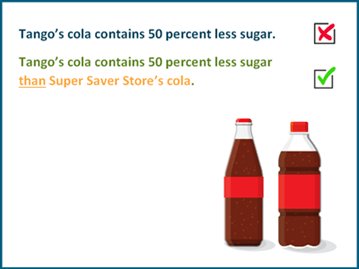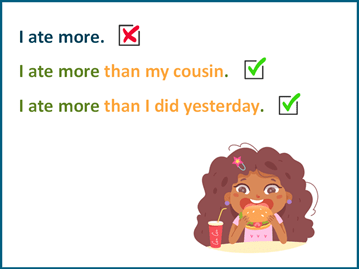Incomplete comparisons
At face value it seems preferable to drink sodas with 50 percent less sugar and use dishwashing liquid that has 30 percent more cleaning power. However, there is something missing in these statements. If you think about these statements, you don’t know what they are comparing themselves to. In essence, you don’t really know if you are making a better purchasing decision with these statements.
For example:
Tango’s cola contains 50 percent less sugar.
If you think about this sentence, it doesn’t carry any validity to it. It only becomes a valid statement when you add ‘than’.
This is called an incomplete comparison. Basically, an incomplete comparison is a comparison that leaves out one of the items being compared.
It’s not just advertisers who use incomplete comparisons. It happens in everyday language too.
For example:
I ate more.
Learning Chinese is more difficult.
Comparative sentences
The rule of creating comparative sentences is that these sentences need to contain two elements. One element being compared to another.
For example:
Tango’s cola contains 50 percent less sugar than Super Saver Store’s cola.

Now you have a direct comparison. Now when you see an ad with an incomplete comparison, you’ll think twice about what they’re really saying.
In everyday language, you can also start to question incomplete comparison statements.
For example:
I ate more.
You ate more than who, what, when?
These are the comparative sentences for the above incomplete comparison:
I ate more than my cousin.
I ate more than I did yesterday.


